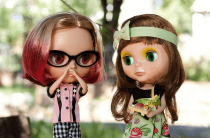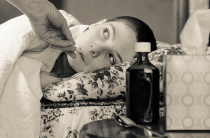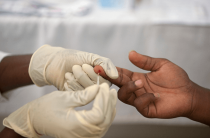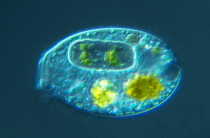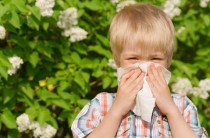May is a beautiful spring month, with moderate warmth combined with good weather and beautiful scenery created by plants blooming in May. Unfortunately, people suffering from allergies in May cannot always appreciate the delights of this month. After all, if a person suffers from an allergy to flowering , then this month can be very difficult for him.
Allergy to flowering in May is a very common occurrence. At this time, quite a lot of plants bloom, each of which can be an allergen, provided that there is an appropriate immunity sensitivity. In May, many fruit trees bloom, followed by cereals and shrubs. The weather at this time is already very dry, which contributes to the intensive spread of allergens in the air, from which it is almost impossible to completely protect yourself.
The pollen of plants that bloom in May is very light and small in size, so it is easily carried by the wind and penetrates literally everywhere. The patient may notice that he has discovered allergy attacks, for example, to birch blossoms, being many kilometers from birch groves. In order to protect yourself from flowering as much as possible, it is not enough just to be far from the places where the allergen plant grows. In order to protect yourself as carefully as possible from flowering plants in May, it is necessary to take the whole range of special measures that will be given in this article below.
And so, the most common culprits of allergies in May are the following plants:
- Trees: birch, maple, alder, ash, linden, poplar;
- Cereals: barley, rye, oats, wheat;
- Herbs: hedgehog, timothy
This list includes only the most common plants that cause allergies in May. An allergic reaction can be to pollen from almost any plant. It should also be remembered that the timing of flowering of certain plants can vary by several weeks, depending on the immediate region in which this plant grows.
Allergy sufferers often make a common mistake in May. They observe allergy symptoms in themselves after being exposed to poplar fluff and begin to think that they are allergic to this particular plant, taking all possible measures to avoid contact with this plant. Alas, poplar fluff , in itself, is absolutely harmless, as an allergen. It is so large that it cannot enter our respiratory system or get into our eyes to cause symptoms of a bloom allergy. Then why does it develop an allergic reaction? The fact is that, having a certain charge during friction, it easily attracts pollen particles, among which may be the flowering of an allergen plant. Therefore, poplar fluff is not an allergen, but only serves as a carrier of allergens.
Symptoms of an allergy to flowering in May
The main feature that allows you to distinguish an allergy to flowering from other types of allergic reactions is the seasonality of this phenomenon, associated with the flowering period of May plants, which, with minor amendments, occurs at the same time of the year in each particular region. Flower allergy is a respiratory allergy, therefore, it is characterized by symptoms of allergic rhinitis, allergic conjunctivitis, as well as asthmatic manifestations.
allergic rhinitis
Allergic rhinitis is virtually synonymous with pollen allergy. With this complaint, patients most often turn to an allergist in the spring. Allergic rhinitis is an inflammatory process that occurs after exposure to an allergen. The mechanisms of the immune response are involved in their development, so the maximum time for the development of these symptoms is 15 minutes.
Allergic rhinitis is manifested by the appearance of a runny nose, frequent clear discharge, swelling of the nasal sinuses, and expansion of local vessels. This leads to nasal congestion and respiratory failure. Immediately after contact with the allergen, continuous sneezing and swelling of the nose develops, other symptoms develop somewhat later.
Allergic conjunctivitis
Allergic conjunctivitis is also an inflammatory process of allergic origin. Only this time, its localization is located in the region of the eyeball and adjacent skin. Allergic conjunctivitis develops just as instantly, in most cases it takes no more than a few minutes from the moment the allergen hits.
Allergic conjunctivitis is characterized by: itching in the eye area, burning sensation, tearing, as well as various secretions, redness of the mucous membrane, photosensitivity, inflammation and redness in the eyelid area. This symptom is often, with an allergy to flowering, combined with allergic rhinitis.
Allergic bronchial asthma
Asthmatic manifestations complete the top three most common symptoms observed in pollen allergy. Bronchial asthma is a narrowing of the bronchial lumen, which is caused by exposure to an allergen. In a patient with allergies, this is expressed by sharp attacks of suffocation, which are accompanied by a dry cough and pressure in the chest.
Bronchial asthma, with allergies, is caused by the activity of special antibodies, the IgE class, which take part in the immediate immune response. Bronchial asthma of an allergic nature manifests itself instantly. For its development, two things are necessary: the presence of an allergic predisposition and the presence of primary contact with the allergen, as a result of which the patient's immunity recognizes the allergen and remembers it as a substance for which it is necessary to produce antibodies. Unfortunately, with an allergy to flowering, the contact of the patient's immunity with allergens occurs much more often than with many other types of allergies.
An important role in the development of allergic bronchial asthma is played by such factors as: infectious lesions of the respiratory tract, often transmitted infectious diseases, high air pollution, tobacco smoking, contact with harmful substances at work.
Flower allergy treatment
Drug treatment of an allergy to flowering includes:
- The use of antihistamines, in the form of tablets (claritin, erius, diazolin, tavegil, clemastine), eye drops (ketotifen, azelastine, allergodil), nasal drops and sprays (allergodil spray, fenistil, zirtek drops).
- The use of systemic corticosteroids (injections, tablets), as well as the use of topical corticosteroids.
- The use of special vasoconstrictor drops.
In the treatment of allergies to flowering in May, immunotherapy is of great importance. This method has proven to be a reliable therapeutic solution for the treatment of allergic diseases that result from the ingestion of flowering plants. It consists in the fact that for a long time, before the onset of flowering of the allergen plant, a solution of the allergen is administered to the patient in a medical hospital. As a result, the body gets used to the constant presence of the allergen and stops responding to it for a while.
Prevention for allergies to flowering
- Do wet cleaning in the house every day. Be especially careful not to allow the accumulation of dust on the cornices and window sills;
- During the flowering period, change tulle, curtains and curtains on the windows as often as possible;
- Wash your face thoroughly after coming from the street.
- When you return from the street, rinse your sinuses with a special saline solution or water for rinsing (available at a pharmacy);
- Remember that the most dangerous time to walk in May is during the day and in the morning;
- The most dangerous weather is dry and windy;
- Use an air conditioner to purify the air in the room;
- Put special screens on the windows
